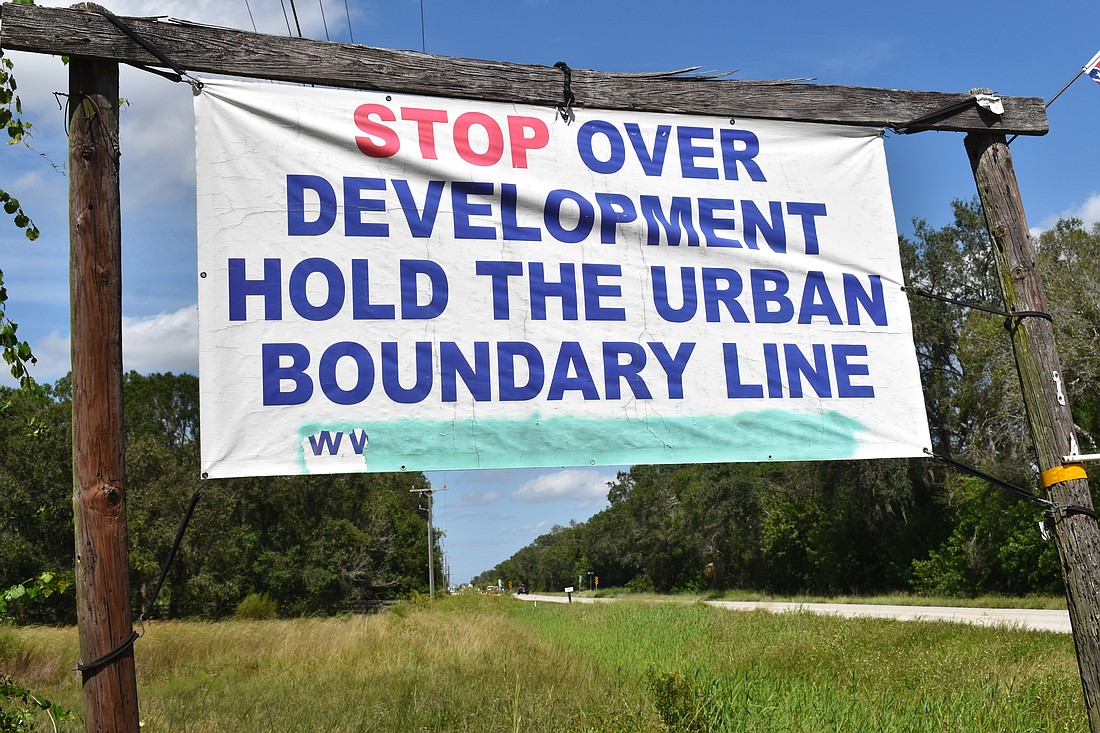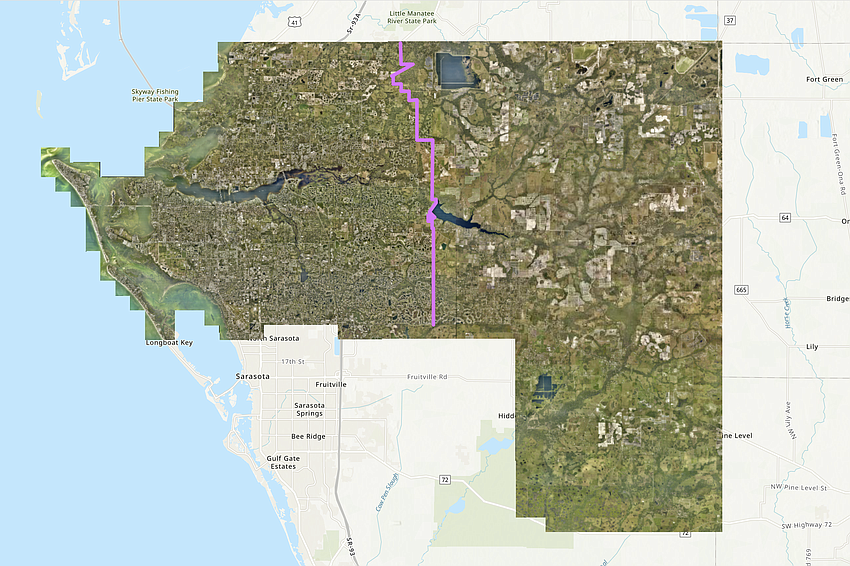- January 14, 2025
-
-
Loading

Loading

As development creeps farther east, District 5 Commissioner Ray Turner has begun to question whether a Future Development Area Boundary is even necessary as Manatee County moves forward.
“I don’t think we need it anymore, but it does need to be staged growth,” Turner said. “Beyond Taylor Ranch, if we’re going on that northern perimeter where there’s some open land and some big land owners, it has to be staged growth to accommodate the sewer and water and to get things organized. We already know we can’t go in there and just do 20,000 homes.”
Turner's comments came in reference to studies, such as a Facility Fees Investment study, being performed by Manatee County to help commissioners understand the cost and repercussions of moving the Future Development Area Boundary to the east.
Questions have arisen whether a boundary is effective anyway since Manatee County commissioners have approved two large residential communities east of the boundary that don't meet county regulations in terms of density.
Those approvals fell under Policy 2.1.2.8 in the Comprehensive Plan and they fell upon the policy's guidelines, such as "The lands generally west of the area to be developed are primarily developed or being developed pursuant to a suburban development pattern," and "The area to be developed must be able to gain access to one or more roadways designated as a thoroughfare in the Manatee County Comprehensive Plan, with any extension of a thoroughfare beyond the FDAB and within the area to be developed to be constructed at the expense of a Community Development, Stewardship District or master developer, serving the area to be developed."
However, not all projects have passed for east of the boundary. Another major project, Pulte Homes' Lazy C. Ranch at County Road 675 and Rye Road North, has been turned down so far. The project is expected to return to the commission Nov. 2.
In the background, those who live in low-density communities and on ranches and farms east of the FDAB have been trying to fight high-density development without success.
Commissioners have said they can make better decisions about development east of the boundary once they have more information about the impacts on traffic and the cost of infrastructure.
The Facility Investment Fees study will at least answer one question: How much will it cost to keep approving projects east of the FDAB if the county wants to have control over the infrastructure being built?

Two projects have been approved east of the FDAB, Schroeder-Manatee Ranch’s Taylor Ranch and Carlos Beruff’s East River Ranch, but both developers signed agreements to pay their own way on roads and utilities.
While Comprehensive Plan policy 2.1.2.8. allowed commissioners to begin approving projects east of the FDAB in 2021, the county is only responsible for infrastructure west of the line, where a FIF study has already been done.
“The (FIF) study shows what smart development costs would be to make sure that development pays for itself and minimizes maintenance and upkeep costs while considering the effects of all development east of the FDAB as far as could be served without major improvements being needed (such as a new plant),” County Engineer Scott May said. “Without looking at the area, it could lead to excessive maintenance and upkeep costs if every developer built their own line to the plant. This is why this study is being completed and once we receive it, we will begin looking at the next steps necessary to address extensions outside of the FDAB.”
When the study was approved at the Sept. 19 work session, Kruse said it was only one piece of the bigger policy issue of 2.1.2.8., which he had tried to get removed from the Comprehensive Plan in a prior session. Instead, staff and commissioners agreed to hold a future work session to discuss the policy.
The staff returned with only the proposal of a FIF study east of the FDAB, but Interim Director of Development Services Nicole Knapp said the study should be done before any revisions because it would “better justify what is coterminous and contiguous.”
Kruse said he is weary of any changes in the line due to 2.1.2.8.’s vague language regarding projects that have already been approved.
“What’s never been memorialized in that policy is what happens in that interim period between approval when they’re east and when they actually put a shovel in the ground and have to pull permits and pay,” he said. “What happens if that line moves and now (the proposed development) is west of the line? The code still says that anything west of that line is county responsibility.”
Would all roads and utilities be the responsibility of the county?
Under the policy, “coterminous” and “contiguous” mean that developments have to build off existing infrastructure. East River Ranch can’t start work until Taylor Ranch has laid its pipes.
So each set of new pipes can lead to a future development to the east.
Commissioners Mike Rahn and Amanda Ballard said Lazy C. Ranch met the conditions of coterminous and contiguous because part of the roughly 500 acres lies west of the FDAB, while Kruse argued that the 90 acres west isn’t enough to support the development of 400 acres to the east.
The FIF study will take about six months to complete and will start the ball rolling toward moving the FDAB, if that is the direction sought by the commissioners.
“We’re talking about adding an FIF fee because to pipe that water back to the water plants, the further you get out, it costs more, so those FIF fees will be added to any type of new home on top of the impact fees, “Commissioner Jason Bearden said. “That’s why we’re still in the infancy stage right now to figure out where that line is going to be, but we’ll probably be working on that in the next couple of years.”
According to Interim Director of Development Nicole Knapp, moving the line will not be a quick and simple task. It requires an amendment to the Comprehensive Plan with a set of technical supporting documents that need to be transmitted to the State Land Planning Agency.
Deputy Director of Development Denise Greer added that it would also require either an updated or new utility master plan.
Is it too much impact for a line that has no real impact?
Bearden said that when the line was established in 1989 as part of the Comprehensive Plan, population growth in the area was about 6,000 annually, half what it is today.
“Obviously, when you’re doubling those numbers, you’re going to hit that line a lot faster than expected,” he said. “The major thing that we have to think about from an economic standpoint is, ‘How many houses do we need in the county to find equilibrium?’”
Bearden said affordable housing isn't a solution to find equilibrium in the market because it doesn’t help enough people. He said meeting the supply and demand is a better route for the entirety of Manatee County’s population.
“Right now, the average price of a home is over $500,000. But a few years ago, you could find a home, even in Lakewood Ranch, for $300,000,” he said. “It’s a good thing that property values are increasing, but it’s not necessarily a good thing from an economic standpoint. If we find out where the equilibrium is, then our economy will continue to thrive with small businesses, taxes and affordability for homes.”
Kruse said the FDAB should stay put because it will be too expensive to move. He said keeping the line in place leaves developers on the hook to pay for roads and utilities.
“My guess is that the rest of this board is going to jump this line on the other side of Taylor Ranch and East River Ranch,” Kruse said. “Now, those developers, before they put a shovel in the ground, are going to say, ‘Whoa, we’re west of the FDAB line now. Our approval is contingent on 2.1.2.8. Therefore, we’re not required to put in our own infrastructure because now it’s the county’s responsibility.’”
Kruse further supposed that the developers will wait out the FIF study and the FDAB because “they’re going to do everything they can to get themselves on the other side of that line.”
“If they hold off pulling permits, and they just conveniently own a bunch of previously rezoned agricultural land, they can make an argument that they didn’t owe any fees, therefore, they’re not grandfathered into the old fee schedule,” he said. “Once they put a shovel in the ground, now, they have to pay the current fee schedule, which would be substantially lower.”